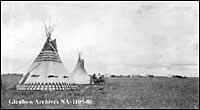First Peoples and Settlers
The North West becomes the West: Natives and Newcomers
Although 19th century writers sometimes described the Canadian west in terms such as "the Great Lone Land" or as an unpopulated frontier, it was actually home to thousands of people. It was also a very diverse place.
 Residents spoke many different languages; they had quite distinctive ways of life, and varied beliefs. In fact, many historians have suggested that the old North West of the fur trade was a fascinating social phenomenon. Sylvia Van Kirk described it as "...a society which recognized the importance of family and kin and in which native women had a vital contribution to make." This society was "...based on a close economic partnership between Indian and white and extensive intermarriage," and its decline "...is to be regretted, for the blending of European and Indian culture could have been an enriching human experience."
Residents spoke many different languages; they had quite distinctive ways of life, and varied beliefs. In fact, many historians have suggested that the old North West of the fur trade was a fascinating social phenomenon. Sylvia Van Kirk described it as "...a society which recognized the importance of family and kin and in which native women had a vital contribution to make." This society was "...based on a close economic partnership between Indian and white and extensive intermarriage," and its decline "...is to be regretted, for the blending of European and Indian culture could have been an enriching human experience."
The Métis, European, and First Nation inhabitants of the old North West faced significant changes when the government of the newly created country of Canada acquired this territory in 1869-1870. Residents of the Red River settlement around the forks of the Red and Assiniboine Rivers resisted this takeover, and forced the government of Canada to create a new province, Manitoba, and a government for the remaining lands, which were called the Northwest Territories.

The government of Canada and the newly created governments for Manitoba and the Northwest Territories were all interested in encouraging settlement of the new lands, but some issues had to be resolved for this to occur. In the Red River settlement, around what would become Winnipeg, Lord Selkirk had acquired a kind of title to the land through a land grant from the Hudson's Bay Company and a treaty with Chief Peguis and the Saulteaux/Ojibwa. Everywhere else though, treaties would be needed before settlement could take place. The Red River Resistance had also raised the issue of the Métis interest in the land, and the legislation creating the new province of Manitoba specifically stated that land should be set aside for the Métis and their children. Beginning in 1871 then, the government of Canada began negotiating a series of treaties with the First Nations of western Canada as a prelude to settlement. At the same time, a system of allocating "scrip", or certificates entitling the owner to claim land, was established for the Métis. These treaties and the scrip process are explained in greater detail in Phase I.
The CKUA Heritage Trails:
- Phase I: Alberta: How the West was Young: First Nations & Métis:
- Phase I: Alberta: How the West was Young: First Nations & Métis:
[top] [back] [New Communities] [New Beginnings] [Adventurous Albertans]









